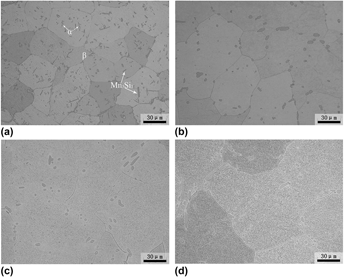Crossref Citations
This article has been cited by the following publications. This list is generated based on data provided by
Crossref.
Li, Hang
Jie, Jinchuan
Liu, Shichao
Zhang, Yubo
and
Li, Tingju
2017.
Crystal growth and morphology evolution of D8 8 (Mn, Fe) 5 Si 3 phase and its influence on the mechanical and wear properties of brasses.
Materials Science and Engineering: A,
Vol. 704,
Issue. ,
p.
45.
Lin, Y. H.
Chuang, W. S.
Huang, J. C.
Chao, C. Y.
and
Chang, C. M.
2019.
Influence from Size and Morphology of Mn5Si3 on Wear Resistance of Cu-Zn-Al-Mn-Si Alloys.
Metallurgical and Materials Transactions A,
Vol. 50,
Issue. 7,
p.
3148.
Ding, Haimin
Zhang, Xiao
Liu, Qing
Miao, Wenzhi
Zhou, Jiyu
and
Wang, Jinfeng
2021.
The microstructures of the TiN–Ti5Si3 hybrid reinforced Cu matrix composites fabricated by the Ti–Si3N4 reaction and its preparation mechanism.
Journal of Materials Research and Technology,
Vol. 14,
Issue. ,
p.
1709.
Gou, Peipei
Niu, Ben
Wang, Na
Dong, Zhigang
Li, Zhen
Wang, Qing
Kang, Renke
and
Dong, Chuang
2022.
Composition-Optimized Cu-Zn-(Mn, Fe, Si) Alloy and Its Microstructural Evolution with Thermomechanical Treatments.
Journal of Materials Engineering and Performance,
Vol. 31,
Issue. 1,
p.
590.
Kong, Beibei
Wen, Daosheng
Wang, Lei
Wang, Lihu
Wang, Shouren
and
Xiao, Teng
2022.
Atomic-Scale Study of Grain Boundary Evolution in the Abrasive Wear of An Al–Li Alloy.
Transactions of the Indian Institute of Metals,
Vol. 75,
Issue. 10,
p.
2547.
Gao, Hongchen
Xue, Song
Ren, Yi
Peng, Yi
and
Zheng, Lixuan
2023.
Failure Analysis of a Brass Synchronizer Ring in the Gearbox of Vehicle.
International Journal of Automotive Technology,
Vol. 24,
Issue. 2,
p.
493.
Li, Xiang
Ma, Baozhong
Wang, Chengyan
Liu, Wei
Zhang, Baoyu
and
Chen, Yongqiang
2023.
Action and segregation mechanism of Fe-rich phase in as-cast brass with different Fe contents.
Journal of Molecular Liquids,
Vol. 371,
Issue. ,
p.
121161.
Keshavamurthy, R.
Kuppahalli, Prabhakar
Sriram, P.
and
Sridhar, K.
2023.
Effect of Silicon Addition on Erosion-Corrosion Characteristics of High-Tensile Brasses.
Journal of The Institution of Engineers (India): Series D,
Vol. 104,
Issue. 1,
p.
155.
